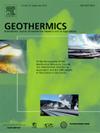The seismic signature and geothermal potential of the Schwechat Depression in the Vienna Basin, Austria, from ambient noise tomography
IF 3.5
2区 工程技术
Q3 ENERGY & FUELS
引用次数: 0
Abstract
The Schwechat depression, in the Vienna Basin (VB) is currently the main target area for deep geothermal exploration in eastern Austria. Knowledge of the subsurface heavily relies on active seismic reflection profiling experiments that are expensive and logistically demanding. Affordable geophysical prospecting methods are needed to reduce subsurface uncertainty over large spatial areas. Over recent years, seismic ambient noise tomography (ANT) has proven to be a cost-effective and environment-friendly exploration technique fulfilling this need. Here, we present an ANT study of the central Vienna Basin revealing the shear-wave velocity, and shear-wave radial anisotropy structure down to 5 km beneath the surface. We deployed an array of 100 seismic nodal instruments during 5 weeks over summer 2023. We measured fundamental-mode Rayleigh and Love-wave group velocity dispersion from seismic noise correlations, and employed transdimensional Bayesian tomography to invert for isotropic Rayleigh and Love group velocity maps at periods ranging from 0.8 to 5.5 s. We then extracted Rayleigh and Love group velocity dispersion curves from the maps at all locations, and jointly inverted them for shear-wave velocity and radial anisotropy as a function of depth using a transdimensional Bayesian framework.
Our shear-wave velocity model reveals a basin-like low-velocity feature, interpreted as the seismic signature of the Schwechat depression. Another low-velocity feature is observed beneath the city of Vienna, which could be of great interest for geothermal exploration. The shear-wave velocity radial anisotropy structure indicates a thin negative anisotropy layer in the top 150 meters, likely associated with water-saturated open cracks. Between 150 meters and 1.5 km depth, we observe widespread positive radial anisotropy across the entire study area, corresponding to sub-horizontal layering within the Neogene basin. At greater depths, the Schwechat depression is characterized by positive radial anisotropy, while the edges of the Schwechat depression exhibit negative radial anisotropy due to steeply dipping strata and normal faults responsible for the formation of this major depocenter in the Vienna Basin.
奥地利维也纳盆地Schwechat凹陷环境噪声层析成像的地震特征和地热潜力
维也纳盆地(VB)的Schwechat凹陷是目前奥地利东部深部地热勘探的主要目标区域。对地下的了解在很大程度上依赖于主动地震反射剖面实验,这些实验既昂贵又需要后勤保障。需要经济实惠的地球物理勘探方法来减少大空间区域的地下不确定性。近年来,地震环境噪声层析成像(ANT)已被证明是一种经济、环保的勘探技术,可以满足这一需求。在这里,我们提出了维也纳盆地中部的ANT研究,揭示了地表以下5公里处的剪切波速度和剪切波径向各向异性结构。我们在2023年夏季的5周内部署了100台地震节点仪器。我们测量了基于地震噪声相关性的基模Rayleigh和Love波群速度频散,并利用跨维贝叶斯层析成像技术反演了周期为0.8 ~ 5.5 s的各向同性Rayleigh和Love波群速度图。然后,我们从所有位置的地图中提取Rayleigh和Love群速度频散曲线,并使用跨维贝叶斯框架共同反演剪切波速度和径向各向异性作为深度的函数。我们的横波速度模型显示了一个类似盆地的低速特征,这被解释为Schwechat凹陷的地震特征。另一个低速特征是在维也纳地下观测到的,这可能对地热勘探很有兴趣。横波速度径向各向异性结构表明,在顶部150米处存在一层薄的负各向异性层,可能与饱和水的开缝有关。在150 ~ 1.5 km深度范围内,我们观察到整个研究区域普遍存在正径向各向异性,对应于新近纪盆地内的亚水平分层。在深部,Schwechat凹陷表现为正向径向各向异性,而其边缘则表现为负向径向各向异性,这主要是由于陡倾地层和正断层造成的。
本文章由计算机程序翻译,如有差异,请以英文原文为准。
求助全文
约1分钟内获得全文
求助全文
来源期刊

Geothermics
工程技术-地球科学综合
CiteScore
7.70
自引率
15.40%
发文量
237
审稿时长
4.5 months
期刊介绍:
Geothermics is an international journal devoted to the research and development of geothermal energy. The International Board of Editors of Geothermics, which comprises specialists in the various aspects of geothermal resources, exploration and development, guarantees the balanced, comprehensive view of scientific and technological developments in this promising energy field.
It promulgates the state of the art and science of geothermal energy, its exploration and exploitation through a regular exchange of information from all parts of the world. The journal publishes articles dealing with the theory, exploration techniques and all aspects of the utilization of geothermal resources. Geothermics serves as the scientific house, or exchange medium, through which the growing community of geothermal specialists can provide and receive information.
 求助内容:
求助内容: 应助结果提醒方式:
应助结果提醒方式:


